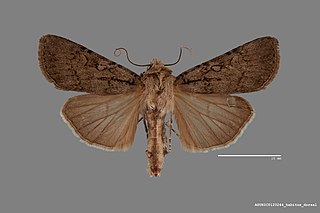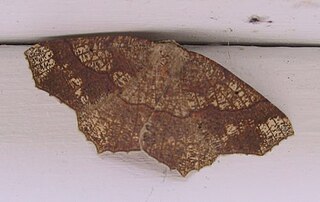
Euxoa is a genus of moths of the family Noctuidae raised by the German entomologist, Jacob Hübner. This genus includes the prolific miller moths, which are full adult army cutworms labeled as the species Euxoa auxiliaris and common in North America.

Euxoa tronellus is a moth of the family Noctuidae first described by Smith in 1903. It is found in western North America from western North Dakota and South Dakota, west across southern Saskatchewan and southeastern Alberta to Washington, south to southern California and northern New Mexico.

Euxoa catenula is a species of moth of the family Noctuidae first described by Augustus Radcliffe Grote in 1879. It is found in North America from southern Saskatchewan west to southern Vancouver Island, south to Kansas, New Mexico, Arizona and southern California.

Euxoa mimallonis is a species of moth of the family Noctuidae first described by Smith in 1890. It is found in North America from Nova Scotia west to coastal British Columbia, south in the east to Michigan and Minnesota, in the west to central California and New Mexico.

Euxoa siccata is a species of moth of the family Noctuidae first described by Smith in 1893. It is found in North America, including Alberta and Colorado.
Euxoa bochus is a moth of the family Noctuidae first described by Herbert Knowles Morrison in 1874. It is found in western North America, from Vancouver Island, south to southern Utah and northern New Mexico, east to central Colorado, Wyoming and the Cypress Hills area of south-western Saskatchewan. It is also present in Manitoba and British Columbia.
Euxoa declarata, the clear dart, is a moth of the family Noctuidae. The species was first described by Francis Walker in 1865. It is found in Canada in Ontario, Quebec, New Brunswick, Nova Scotia, Prince Edward Island, British Columbia, Alberta, Saskatchewan, Yukon and Manitoba. It is found as far west as central Alaska. In the United States it is also found to Minnesota and North Carolina in the east and Arizona, New Mexico and California in the west.

Euxoa detersa, the rubbed dart, sandhill cutworm or sand cutworm, is a moth of the family Noctuidae. The species was first described by Francis Walker in 1856. It is found in North America from Newfoundland to North Carolina, west to Nebraska, north to Alberta and the Northwest Territories.
Euxoa aequalis is a moth of the family Noctuidae first described by Leon F. Harvey in 1876. It is found in Canada from British Columbia, Alberta, Saskatchewan and Yukon, south into the United States, where it has been recorded from Colorado, Wyoming and California.

Euxoa albipennis is a moth of the family Noctuidae first described by Augustus Radcliffe Grote in 1876. It is found from coast to coast in southern Canada and the northern parts of the United States, ranging southward in the west to New Mexico, Arizona and California.
Euxoa atomaris is a moth of the family Noctuidae first described by Smith in 1890. It is found in North America from North Dakota, southern Alberta and British Columbia, south to central New Mexico, Arizona and southern California.
Euxoa auripennis is a moth of the family Noctuidae first described by J. Donald Lafontaine in 1974. It is found in western North America from eastern North Dakota and south-western Manitoba west to central British Columbia, south to southern California and Colorado.
Euxoa aurulenta, the dune cutworm, is a moth of the family Noctuidae. The species was first described by Smith in 1888. It is found in North America from Ontario west to Alberta and Washington, south to Illinois, Nebraska, Colorado and Arizona.
Euxoa brevipennis is a moth of the family Noctuidae first described by Smith in 1888. In Canada, it is found in British Columbia, Alberta and Saskatchewan. In the United States, it has been recorded from Utah, Colorado and California.
Euxoa castanea is a moth of the family Noctuidae first described by J. Donald Lafontaine in 1981. It is found in North America from the North Dakota, South Dakota and south-western Manitoba west to central western British Columbia, north to the Northwest Territories and south in the mountains to Arizona and New Mexico.

Euxoa choris is a moth of the family Noctuidae first described by Leon F. Harvey in 1876. It is found in North America from south-western Saskatchewan, central Alberta and south-central Yukon, south to New Mexico, Arizona and California.
Euxoa cicatricosa is a moth of the family Noctuidae first described by Augustus Radcliffe Grote and Coleman Townsend Robinson in 1865. It is found in North America from south central Saskatchewan west to southern interior British Columbia; south to southern California, Arizona, New Mexico and western Texas; east to western Nebraska and North Dakota.

Euxoa citricolor is a moth of the family Noctuidae first described by Augustus Radcliffe Grote in 1880. It is found in North America from eastern South Dakota and western North Dakota, northwest to southern Alberta, west to western Washington and south and east to southern California, New Mexico and Colorado.
Euxoa dargo is a moth of the family Noctuidae first described by Strecker in 1898. It is found in North America from south-eastern Manitoba west to the southern interior of British Columbia, south to Oregon, southern Idaho and northern New Mexico, and east to eastern South Dakota.

Besma quercivoraria, the oak besma, is a moth of the family Geometridae. The species was first described by Achille Guenée in 1857. It is found across southern Canada and all of the United States except California.







